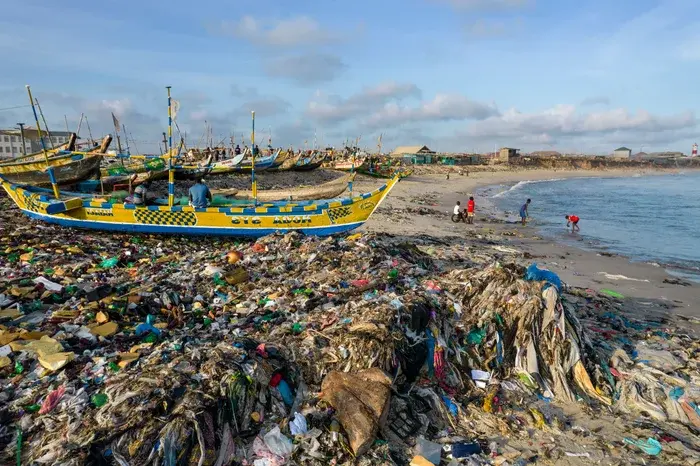From Gold Coast to Pollution Coast: The Fashion Necropolitics of Ghana's Beaches
- Amahle Gebane

- Mar 25
- 4 min read
Updated: Apr 1
Ghana’s beaches have long been victims of Western hyperconsumption and gluttony. Hundreds of enslaved Africans were trafficked through the Atlantic to the West, the only thing that has returned from the West through the Atlantic is... waste. Fast fashion—cast-off clothing from affluent countries—pollutes the land and waters.

Necropower and Fashion
The pollution of Ghana’s beaches is an example of necropower, the power to decide who lives and who is left to die. Achille Mbembe's theory of necropower explores how entities have the power to determine who lives and who dies, often through systemic neglect and violence (Mbembe, 2019).
But how does this relate to hyperconsumption and fashion trends?
By dumping 'out-of-trend' clothing onto Ghanaian beaches, Western consumers systemically designate African land and people as sacrifice zones—places where environmental degradation and exploitation are deemed acceptable for the sake of maintaining hyperconsumerism elsewhere.
This is necropower in action: entire communities are systemically forced to endure the ecological consequences of a system that prioritizes profit and aesthetic trends over human lives. Environmental destruction is one heck of a killer - hence this is necropolitical.
The Brief History

Symbolically, the pollution of Ghana's beaches by discarded fast fashion reflects a deeper, more insidious relationship between the African continent and the West—a relationship defined by disposability and exploitation.
The first Industrial Revolution in Europe (the start to modern consumerism) was built on the backs of enslaved African labor and the plundering of African natural resources. It necessitated the establishment of exploitative markets that would feed the growing capitalist system.
Therefore, the current cycle of Western hyperconsumption—where the latest trends in fast fashion are discarded once deemed obsolete—reflects the same extractive logic, as African lands and people are once again reduced to commodities, serving the desires of the global 'north' without regard for environmental or social costs. The waste washing up on Ghana’s beaches is not just the result of overconsumption—it is also shaped by deeper historical biases in fashion trends.
Clean Girl Aesthetic vs BBL Fashion War

While the "clean girl" aesthetic is marketed as polished and aspirational, it upholds Eurocentric beauty ideals under the guise of simplicity and refinement. Meanwhile, (depicted as a moral foil) "BBL fashion" is framed as excessive and hypersexualized, reinforcing colonial hierarchies that have long deemed Blackness as deviant and excessive. But in reality, both aesthetics are products of the same fast fashion system—one that capitalizes on fleeting trends, exploits labor in the Global South, and ultimately offloads its waste onto African nations.
Beneath the “clean girl aesthetic,” lies a troubling paradox: a 'clean' aesthetic causing filth on African beaches. This aesthetic relies on the colonial equivalence cleanliness with purity and morality. That is why avid subscribers of this aesthetic depict BBL fashion as a moral and aesthetic foil to the 'clean' girl aesthetic -- ka polyester nogal. Neither aesthetic is inherently better for society.. There is no moral pedestal one can stand on just for wearing a white polyester skirt. Thinking that one looks 'richer' and 'less fast fashion-like' for wearing a cheap Club Monaco imitation is uhm... delulu.

Moreover, by positioning the "BBL" aesthetic as a foil to this 'aspirational' and 'refined' clean girl aesthetic taps into a long-standing colonial association between whiteness, cleanliness, and morality - while Black expression is deemed dirty, chaotic, and immoral. The colonial project did this to force Black people to adhere to Eurocentric standards of dress and decorum.
Mind you, 'BBL' fashion is not perfect but it is deeply tied to Black culture, celebrating fuller figures, bold self-expression, and aesthetic choices that embrace and accommodate stereotypically Black bodies. BBL fashion is racialized as Black, even when adopted by non-Black women.

Furthermore, calling it “BBL fashion” —derived from Brazilian Butt Lift surgery—implies that curvy, hyper-feminine Black women’s bodies are unnatural, surgically enhanced, or performative rather than valid and inherent. This framing problematizes Black women’s bodies in several ways:
1. It Pathologizes and Exoticizes Black Features
2. It Reinforces the Idea That Black Beauty Is Constructed, Not Innate
3. It Plays Into the Policing of Black Women’s Bodies
Black women’s bodies have historically been labeled as either hypersexual and undesirable and inappropriate.
This is not to glorify BBL fashion, however it is to show that no 'aesthetic' holds moral superiority. Again, one of the most tragic consequences of this hyperconsumption WAR is the destruction of Ghanaian beaches. As a dumping ground for discarded fast fashion, Ghana's coastline is inundated with textile waste from Western overconsumption. The illusion of "cleanliness" in fashion is therefore a contradiction—the industry markets an aesthetic of refinement and sustainability while actively contributing to pollution, ecological harm, and the exploitation of African land and labor.

In this way, the destruction of African ecosystems becomes inextricably linked to the unethical consumption habits of the West, manifesting both physically on the beaches of Ghana and symbolically in the exploitation of African people and their resources.
This is not just about fashion—it is about necropower, disposability, and the global hierarchies that determine whose bodies and environments are worthy of care. The same colonial logics that once justified the extraction of African labor now rationalize the mass pollution of African lands, all in service of fleeting trends. And once again, Africa will be left paying the price for Western excess.

Comments